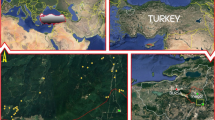Abstract
A study was conducted in central Ethiopian highland in 2008 to investigate the consumption of house construction wood, the tree species preference for construction wood and the forthcoming conditions of this forest product and possible strategies for future availability. Twenty-four iron-roofed houses and twenty-eight thatch-roofed houses belonging to thirty-six farm households were investigated for types, volumes and sources of construction wood used. It was found that an average farmhouse with a floor space of 57 m2 consumed about 13.7 m3 of wood. Both floor space and wood consumptions vary with house types. An average iron-roofed house with floor space of 51.9 m2 consumed 16.8 m3 of wood and an average thatch-roofed house with mean floor space of 28.6 m3 consumed 3.2 m3 of wood. Family size and floor space were the major factors influencing construction wood consumption. An average living house was composed of woods of 39.3% Juniperus procera, 5.6% Cupressus lusitanica, 29.2% Eucalyptus globulus and 26% Eucalyptus camaldulensis. The wood volume from the first two species and half that of the third species were obtained from state forest which is currently banned from any construction wood extraction and hence there is a shortage of around 59.5% of woods. We suggest the promotion of various tree planting approaches to increase the wood supply and the use of alternative local materials like soil bricks for house construction.
Similar content being viewed by others
References
Adhikari B, Falco SD, Lovett JC. 2004. Household characteristics and forest dependence: evidence from common property forest management in Nepal. Ecological Economics, 48: 245–257.
Aregu L, Demeke F. 2006. Socio-economic survey of Arba-Minch riverine forest and woodland. Journal of the Drylands, 1(2): 194–205.
Banks DI, Grippin NJ, Shackleton CM, Shackleton SE, Mavrandonis JM. 1996. Wood supply and demand around two rural settlements in a semi-arid savanna, South Africa. Biomass and Energy, 11(4): 319–331.
Cavendish W. 2000. Empirical irregularities in the poverty-environment relationship of the rural households: evidence from Zimbabwe. World Development, 28: 1979–2000.
CSA (Central Statistical Authority of Ethiopia). 1996. Statistical report on housing characteristics of Oromiya regional state. Addis Ababa, Ethiopia: Central Statistical Authority, p. 276.
Dames JF, Scholes MC, Starker CJ. 1998. Litter production and accumulation in Pinus patula plantations of the Mpumalanga Province, South Africa. Plant and Soil, 203: 183–190.
Dharani N. 2002. Field guide to common trees and shrubs of East Africa. Cape Town, South Africa: Struik Publishers, p. 320.
Duguma LA, Hager H, Gruber M. 2009a. The community-state forest interaction in Menagesha Suba area, Ethiopia: the challenges and possible solutions. Forests, Trees and Livelihoods, 19: 111–128.
Duguma LA, Hager H. 2009b. Forest products scarcity perception and response by tree planting in the rural landscapes: farmers’ views in central highlands of Ethiopia. Ekológia (Bratislava), 28(2): 158–169.
EARO (Ethiopian Agricultural Research Organization). 2002. Strategies for forestry research. Addis Ababa, Ethiopia: Ethiopian Agricultural Research Organization, p. 137.
Escobal J, Aldana U. 2003. Are nontimber forest products the antidote to rainforest degradation? Brazil nut extraction in Madre De Dios, Peru. World Development, 31: 1873–1887.
Florentine SK, Westbrooke ME. 2004. Restoration on abandoned tropical pasturelands — do we know enough? Journal of Nature Conservation, 12: 85–94.
Forest Service British Columbia. 2007. Scaling manual. British Columbia, Canada: Forest Service British Columbia, p. 492.
Gillespie AJR. 1992. Pinus patula Schiede and Deppe. Patula pine. Pinaceae. Pine family. Washington DC: USDA Forest Service, Southern Forest Experiment Station, Institute of Tropical Forestry, p. 5.
Jagger P, Pender J. 2003. The role of trees in the sustainable management of less-favored lands: the case of eucalyptus in Ethiopia. Forest Policy and Economics, 5: 83–95.
Mamo G, Sjaastad E, Vedeld P. 2008. Economic dependence on forest resources: a case from Dendi district, Ethiopia. Forest Policy and Economics, 9: 916–927.
Morel JC, Mesbah A, Oggero M, Walker P. 2001. Building houses with local materials: means to drastically reduce the environmental impact of construction. Building and Environment, 36: 1119–1126.
Narain U, Gupta S, Veld K. 2008. Poverty and resources dependence in rural India. Ecological Economics, 66: 161–176.
SPSS Inc. 2006. Statistical Packages for Social Sciences for Windows. Release 15.0.0. Chicago, SPSS Inc.
Stainback GA, Alavalapati JRR. 2004. Restoring longleaf pine through silvopasture practices: an economic analysis. Forest Policy and Economics, 6: 371–378.
Thomas I, Bekele M. 2003. Role of planted forest and trees outside forests in sustainable forest management: Republic of Ethiopia country case study. Working paper FP/29E. Rome, Italy: FAO, p. 57.
Tiwari P. 2001. Housing and development objectives in India. Habitat International, 25: 229–253.
United Nations. 1948. Universal declaration of human rights. Paris, France: United Nations General Assembly. Retrieved September 23, 2008 from http://en.wikisource.org/wiki/Universal_Declaration_of_Human_Rights
Vishwanatham MK, Samra JS, Sharma AR. 1999. Biomass production of trees and grasses in a silvopasture system on marginal lands of Doon Valley of north-west India. 1. Performance of tree species. Agroforestry Systems, 46(2): 181–196.
Wall DM, Wells J, Uhde M, Sy A. 1998. The market for construction wood in Mopti, Mali. Habitat International, 22(4): 523–536.
Wells J. 1995. Population, settlements and the environment: the provision of organic materials for shelter: a literature review. Habitat International, 19(1): 73–90.
Wells J, Haddar F, Uhde M, Sy A. 1998. Shelter provision in the context of deforestation: some evidence from Mali. Habitat International, 22(4): 463–475.
White L. 2005. Silvopasture literature review. Canada: Saskatchewan Forest Centre, p. 36.
Author information
Authors and Affiliations
Corresponding author
Rights and permissions
About this article
Cite this article
Duguma, L.A., Hager, H. Consumption and species preference for house construction wood in central highlands of Ethiopia — implications for enhancing tree growing. Journal of Forestry Research 21, 104–110 (2010). https://doi.org/10.1007/s11676-010-0018-y
Received:
Accepted:
Published:
Issue Date:
DOI: https://doi.org/10.1007/s11676-010-0018-y




